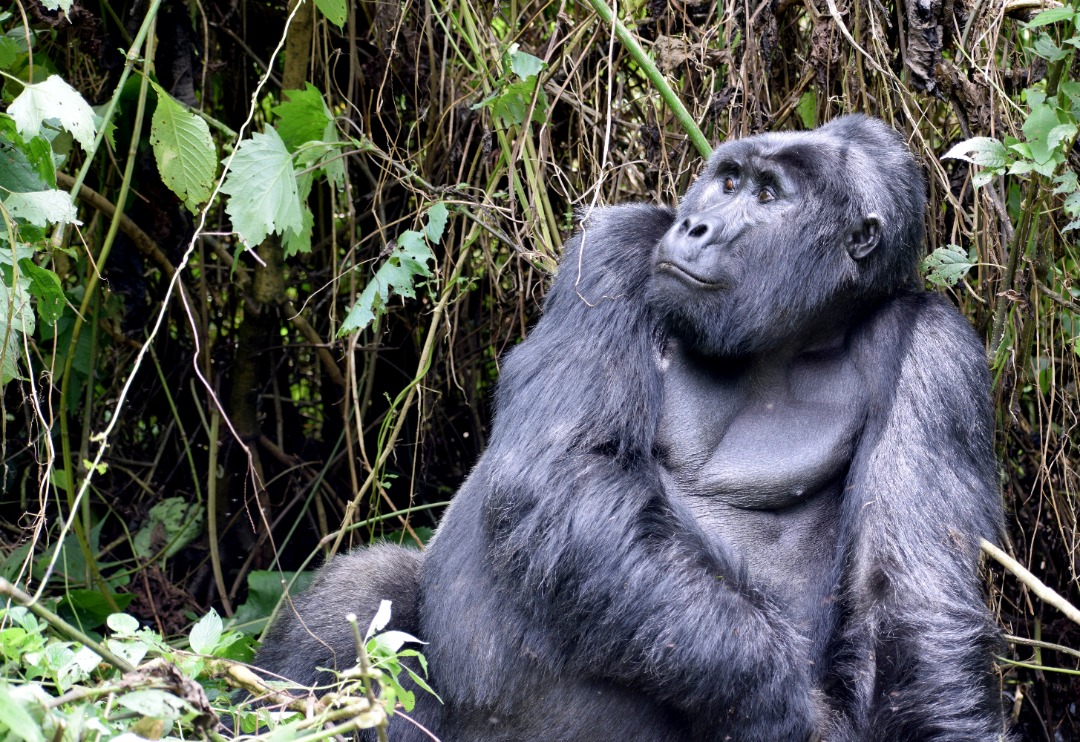
Mountain Gorillas: All you need to know about the endangered great apes
Gorillas are the largest anthropoid (human-like) apes . The shape and face of the gorilla are as unmistakable as its scientific name Gorilla gorilla. There are three subspecies. The most common is the western lowland gorilla found in the equatorial forests of Africa’s Atlantic coast. This is the variety most familiar with zoo goers, for virtually all gorillas in captivity are western lowland gorillas. Separated by hundreds of miles from the western animals is the range of eastern lowland gorillas (Gorilla gorilla graueri). Between 2,500 and 4,500 of these live in the forests of eastern Zaire . Rarest of is the mountain gorillas (Gorilla gorilla beringei). These can only be found in only three countries in whole world; In Rwanda’s Volcanoes national park, DR Congo’s Virunga national park and the highest number of over 50% found in Uganda’s famous Bwindi impenetrable national park and Mgahinga gorilla park.
The difference between the mountain and the eastern lowland subspecies are not easily recognizable. Both have long blackish fur, which at least distinguishes from the western types, whose fur is shorter and browner. The mountain gorilla has a higher crowned head, which makes it seem larger than the eastern lowland variety.
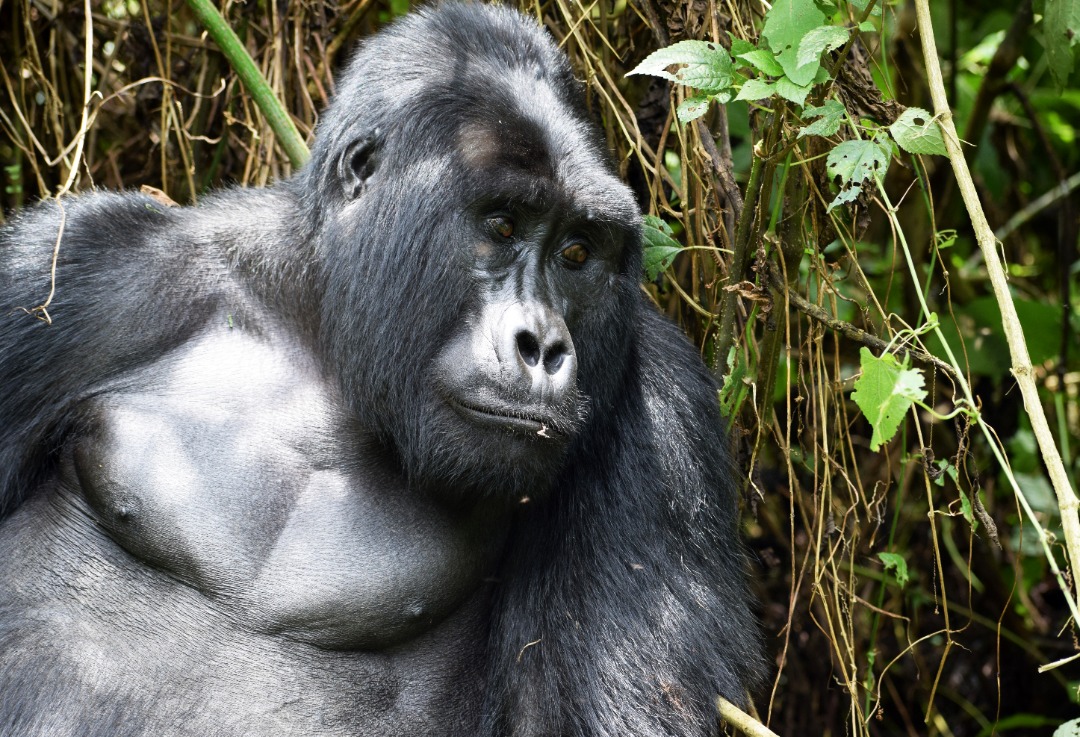
Male Mountain Gorilla
Considerable differences exist between sexes. Females reach a maximum size of about 5 feet in height. They weigh from 15 to 240 pounds. Males reach just under 6 feet in height, and may weigh up to 440 pounds. Males of this imposing size are called silver backs because of the distinguishing gray mantle they develop at maturity.
Gorillas live in family groups. These consist of a dominant silver back male, his females with their dependent offspring, and juveniles of both sexes. Lowland gorilla group tend to be small, while bands of mountain gorillas may number up to thirty animals. Such large groups may contain several fully mature silver backs.
Life in a group is a peaceful one. Gorillas wake early and begin snacking off the foliage around their nest, generally not getting into serious foraging before 8am. It then takes a couple of hours of determined eating to fill their large bellies, after which they rest for several hours. They resume activity in mid-afternoon, feeding and roaming until settling down before dusk. Each individual makes its own simple nest, folding underneath itself any leaves and branches that are conveniently within reach. Young up to about three years old sleep in the mother’s nest. These gorillas make their nests on the ground, with only the odd juveniles bedding down in the lower branches of the trees. New nesting site are used each night.
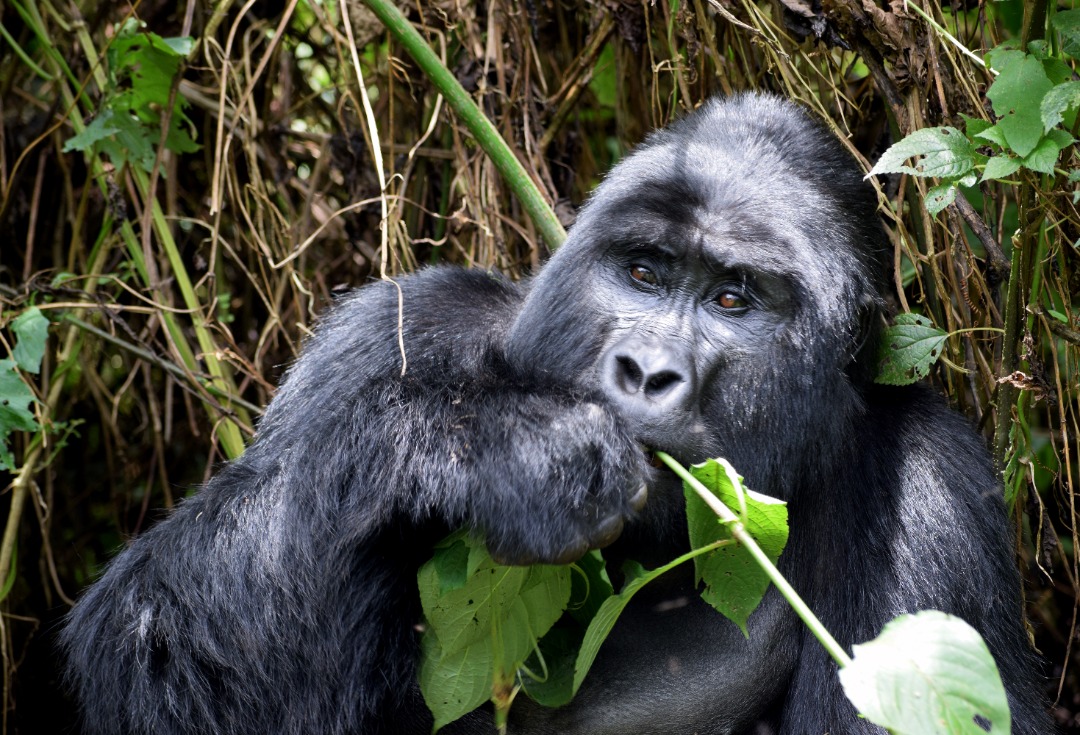
Mountain Gorilla feeding
Gorillas are vegetarians. They eat a wide range of plants including leaves, shoots, barks, roots and fruits. In the Virungas, they are especially fond of wild celery (it looks like the stuff you buy in the market), purple-flowering vernonia shrub, nettles, and tender bamboo shoots. Gorillas do not have to drink water. They get all they need from the enormous quantities of juicy plants they consume.
Females give birth at intervals of four years. Infants are quite helpless; the female have to carry their clutching charges everywhere. By six months, the young ca n scramble around on their own while the group is feeding or resting. They remain dependent on their mother up till about age four.
A dominant silver back is the leader and protector of his group. He will share females sexually with other mature males in his own group, but if strange males try to steal them, there may be serious fighting. Young females frequently transfer out to new groups in that way. If the dominant silver back weakens through age or disease and become unable to defend his family, the females will be taken over by neighboring males. When a silver back dies, all females are taken by rivals, unless there is another fully mature silver back already in the group who can defend it. One the females are gone, all that remains of the group will be the juvenile males who stay together. One day they will try to abduct females for themselves. When the silver back succeeds in the taking a new female, he kills her newborn offspring. This infanticide causes the female to come into estrus again as soon as possible, thus giving the silverback an early chance to reproduce.
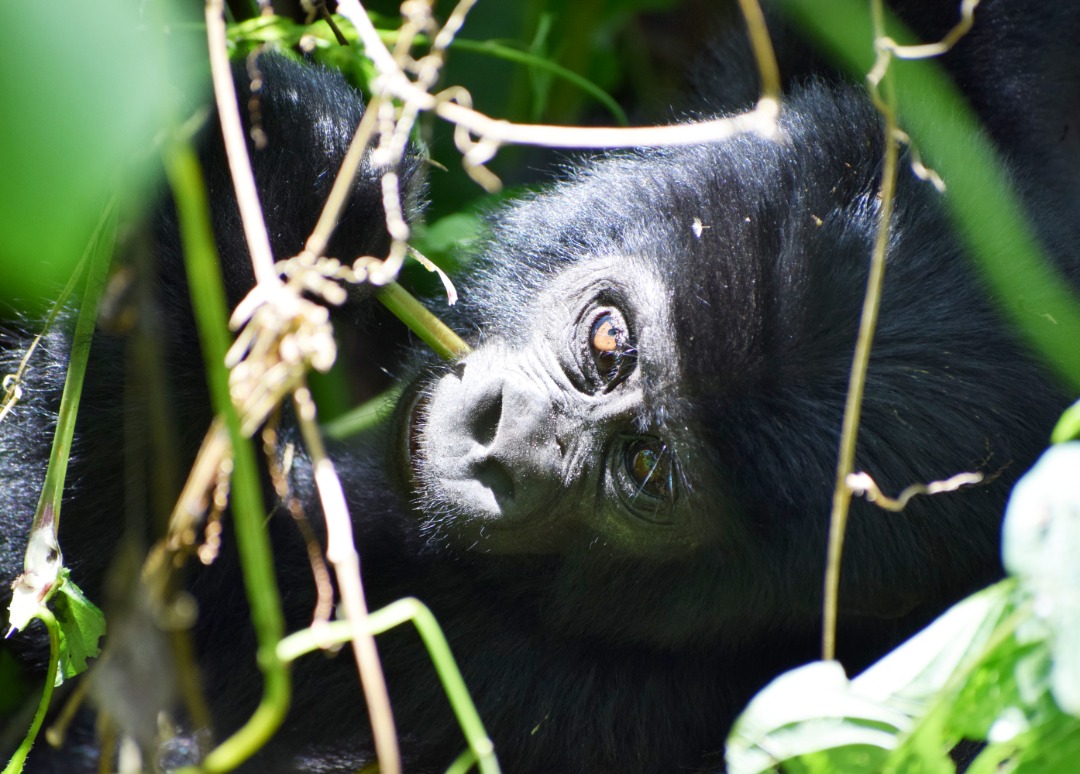 Most days gorillas do not move great distances, often not more than a kilometer or two. They travel single file, walking on all fours. They sometimes climb as high as the zone of the giant senecios, but most remain lower down in the hagenia forest. When new shoots are plentiful, gorillas spend a lot of time feeding in the bamboo groves.
Most days gorillas do not move great distances, often not more than a kilometer or two. They travel single file, walking on all fours. They sometimes climb as high as the zone of the giant senecios, but most remain lower down in the hagenia forest. When new shoots are plentiful, gorillas spend a lot of time feeding in the bamboo groves.
Gorillas rarely walk bipedally. Walking on two feet is reserved for shot distances only, and is often associated with threat displays. Chest beating is practiced by males from a very young age. Among silverbacks, chest beating is a means of communicating to rival groups. The popping sound can be heard at a distance, so direct confrontation can be diplomatically avoided. The chest beat is also a dramatic part of the silverback’s threat charge.
These great apes have few enemies, although leopards have been reported for taking babies. The chief cause of death among mountain gorillas are respiratory diseases such as pneumonia.
Humans are the major threat to mountain gorillas. Poaching is the most publicized problem because it produces grisly photographs of animals with several heads and missing hands. The activity gets a lot of press attention, and is usually blamed on the tourists’ insatiable demand for souvenirs. In fact, most gorillas killed in profit hunting schemes die because poachers are seeking young animals for sale to zoos and private collectors. To get to the young, poachers must kill both the silverback and the mother. Whole group can be destroyed to obtain infants, which usually die before they reach their place of ultimate captivity.
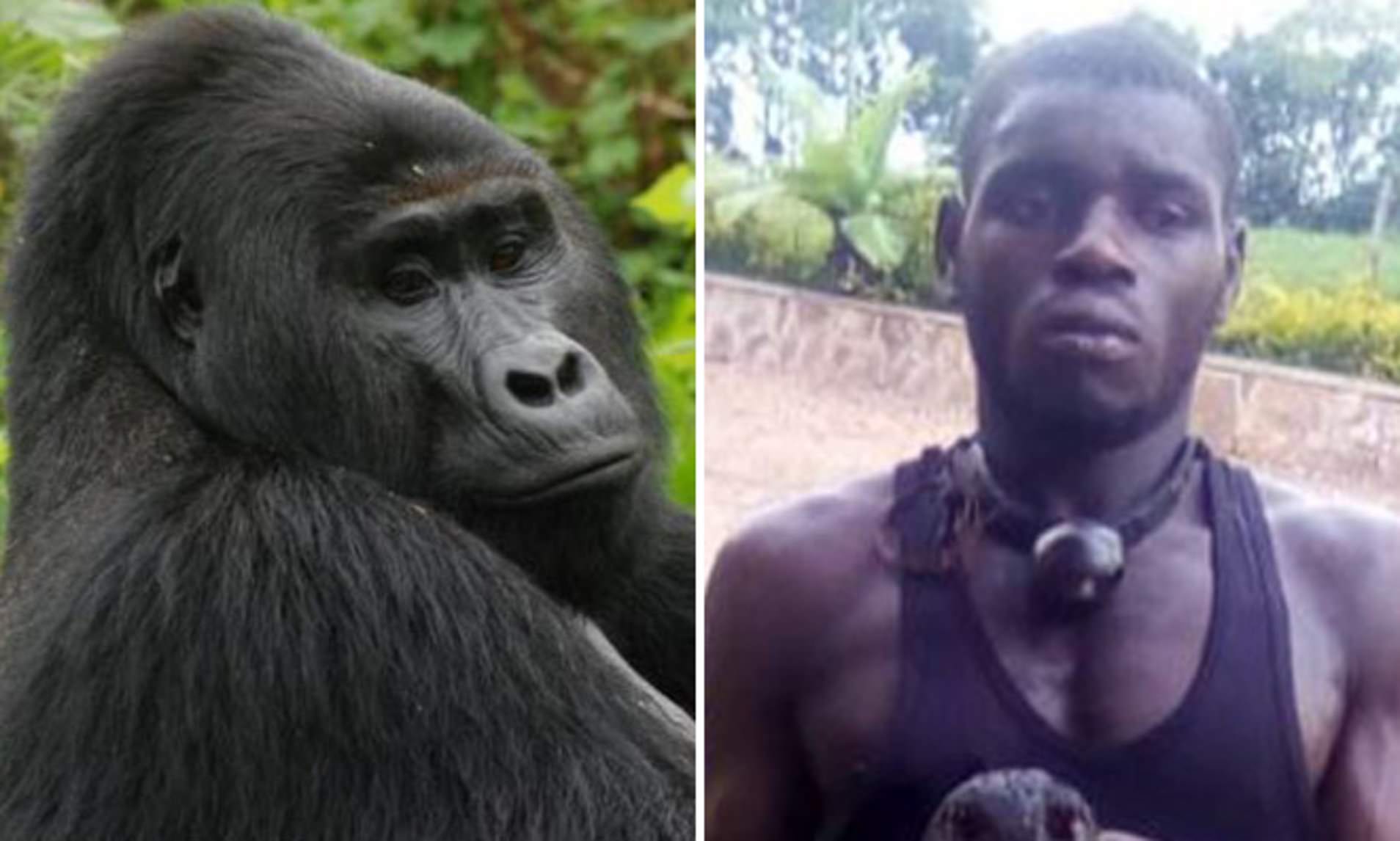 Incidental poaching is serious threat; some Batwa people who used to reside in the forest are conservative and tend to look for bush meat which they used to enjoy while in the forest. They often set snare traps in the park hoping to catch small antelopes for the pot. Unfortunately, snares don’t discriminate. If a gorilla catches its hand in the wire, it may suffer terrible lacerations struggling to free itself. The wounds often infect and lead to crippling disfigurement or death.
Incidental poaching is serious threat; some Batwa people who used to reside in the forest are conservative and tend to look for bush meat which they used to enjoy while in the forest. They often set snare traps in the park hoping to catch small antelopes for the pot. Unfortunately, snares don’t discriminate. If a gorilla catches its hand in the wire, it may suffer terrible lacerations struggling to free itself. The wounds often infect and lead to crippling disfigurement or death.
In July 2020, a poacher by names of Byabakama speared and killed a famous silverback know as Rafiki in Bwindi impenetrable national park. He admitted to the UWA previously that he, and three others had gone to Bwindi Impenetrable National Park with the intention of hunting smaller animals and that he killed Rafiki in self-defense when he was attacked.
The silverback, believed to be around 25-years-old when he died, was the leader of a group of 17 mountain gorillas.
Although poaching is the most visible threat to gorillas, it actually runs a poor second to habitat destruction. As long as the ape’ s available living space continues to shrink, its numbers will decline.
On the other side, the very success of conservation through tourism raised new concern about the welfare of the gorillas. Some fear that the great apes may succumb to infectious disease; this was witnessed in 2020 when Uganda wildlife Authority closed the parks where gorilla safaris in Uganda, Bwindi impenetrable national park & Mgahinga Gorilla Park as well as chimpanzee tracking, Kibale national park are done in fear the endangered species and close relative to humans would contract COVID-19 virus. The reports of the low land gorilla in a zoo in America stirred fear in the authorities hence a good move to close the parks from access of tourists.
The Authority is now strict with the SOPs while trekking the gorilla; trekkers’ feet are disinfected and hands sanitized right at the entry of the briefing point. Before drawing close to the primates, they are sanitized again and a mask is must.
Such measure depict a clear future of this great apes and it will give more people a chance to catch a glimpse of the unique creatures generations to come.
Read More